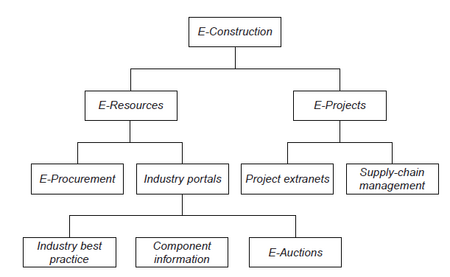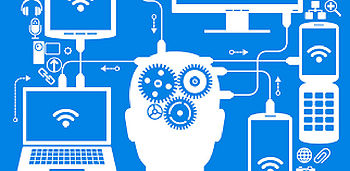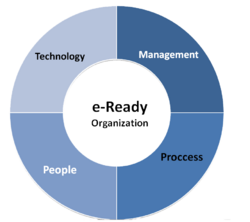E-construction and ICT
(→The Big Idea) |
(→The Big Idea) |
||
| Line 12: | Line 12: | ||
= The Big Idea = | = The Big Idea = | ||
| + | |||
| + | [[File:e-business.png|thumb|450px|The shape of e-construction <ref name="Winch">Graham M. Winch (2010), “Managing construction projects”, 2. edition, Wiley-Blackwell. </ref> ]] | ||
| + | |||
Generally, e-business can apply to every industry, but the implementation of e-business in the construction industry is defined as the conduct of construction business by electronic means. | Generally, e-business can apply to every industry, but the implementation of e-business in the construction industry is defined as the conduct of construction business by electronic means. | ||
| Line 19: | Line 22: | ||
* '''E-projects:''' post contract business – Managing project information flows or the supply chain. | * '''E-projects:''' post contract business – Managing project information flows or the supply chain. | ||
| − | |||
| − | |||
The subcategories include e-procurement, e-portals, project extranets and supply-chain management. | The subcategories include e-procurement, e-portals, project extranets and supply-chain management. | ||
Revision as of 14:38, 20 June 2017
The construction industry has undergone enormous changes since 1990, due to the growth of the internet, which changed the information flows on construction projects. These changes are grouped under the term e-construction.
E-construction is the use of electronic technology or information and communication technology (ICT) to change traditional processes. The evolution of ICT in the recent years has changed the process of information creation, storage and access. Through fixed ICT agreements the optimal foundation for digital collaboration in the project is created. These terms are defined when the project agreements between the client and consultant are established, but can be subjected to updates during the project lifetime.
A specific tool in the form of BIPS’ A102 - ICT specification tool will be examined. This tool yields the basis for the different parties in a construction project to compose terms of reference for classification, digital communication, communication platform, digital project design, digital tendering, quantities and digital handover. Different models in the specification tool will be presented corresponding to varying demands towards ICT from the client.
In the end, the limitations of the ICT specifications and eventual improvements required for success and the future of the ICT specifications will be outlined.
Contents |
The Big Idea

Generally, e-business can apply to every industry, but the implementation of e-business in the construction industry is defined as the conduct of construction business by electronic means.
The applications of e-construction fall into two broad fields.
- E-resources: Pre-contract business - search for resources in the form of people, components and suppliers.
- E-projects: post contract business – Managing project information flows or the supply chain.
The subcategories include e-procurement, e-portals, project extranets and supply-chain management.
- E-procurement is the use of information and communication technologies to conduct digital tendering, which normally follows a reverse auction system.[1] The e-procurement makes it possible for the client to send out project specifications digitally and for the participants in the tendering process to submit their proposals digitally.
- E-portals is the creation of databases containing suppliers of people or components, which makes it easier for the client to find and invite relevant suppliers to the given project. These portals also make it possible for the suppliers to advertise services, which may otherwise be unknown to the client.
- Project extranets utilize the information and communication technologies in improving the interactions and collaboration between the different members of the project coalition. This includes digital distribution of drawing material and documentation between the members with 24/7 availability and with version control implemented, whereby the member responsible for changes are tracked. This process is made easier with the introduction of Building information models, where the models contains a full 3d model from which the drawing material can be extracted and documentation of the included components in the form of material, geometrical and economical properties etc.
- Supply-chain management will not be discussed further in this article.
The implementation of e-business in the construction industry has been relatively inefficient compared to other engineering sectors as for example the automotive or the aerospace industry.[2] The main reasons for this inefficiency is the fragmented structure of the construction industry, where a lot of practitioners needs to collaborate during a given project, and the uniqueness of a construction project. The construction of a building cannot be done with the use of an assembly line as each project requires specific components.
To mitigate this inefficient utilization of e-business in the construction industry regulations needs to be implemented, which can be specified separately for each project.
Application
The implementation and utilization of information and communication technologies in construction is legally regulated differently from country to country. The regulations for the digital construction in Denmark is defined in the ICT-declarations for public and general construction [3] [4], which is a compilation of general requirements for the use of ICT in a construction project.
The construction knowledge center MOLIO [5] has sought a way of defining the ICT-declarations in a simple and clear format, easy to read for the different parties in the construction industry, who not necessarily has advanced knowledge of law. This process has resulted in the newest release of the ICT-specification tool: A102 ICT-specifications 2016. The specification is created in a wide collaboration with the construction industry in the form of user groups, competent feedback, test panels etc. [6]
The purpose of the A102 ICT-specifications 2016 is to support different parties in a construction project specifying and contracting the required ICT service, which should ease the digital collaboration and prevent responsibility issues. The ICT services are separated into the following seven categories, which should all be specified:[7]
| Category | Specifications |
|---|---|
| Classification | The purpose and extent of the use of classification and identification is specified. Classification and identification should as a minimum be specified in tender lists, building models and tender documents. Furthermore, the classification system and identification method is to be specified. Ref: CCS etc. |
| Digital Communication | The platform for communication and file sharing is specified, where standardized platforms and file formats should be preferred for the benefit of the entire organization. Furthermore, the general folder structure and metadata used for identification, is to be specified |
| Establishing a communication platform | The party responsible for the communication platform and the maintenance of it is specified. Furthermore, the administrator of the system is appointed. |
| Digital project design | General structure and features of the project design model is specified. Additionally, the general layout of drawings in the form of layer structure, the drawing/font sizes and the file format for sharing. In this step, the reference system is also placed fixed to a predetermined reference point, which indicates the construction projects initial point. |
| Digital tendering | The responsible and administrator of the tendering portal is appointed. Furthermore, the layout of the tender material is specified together with the required file format for the specific parts of the project material. |
| Quantities | It is here specified if quantities are part of the tender material and if yes, to which extent these quantities are specified. Furthermore, it is specified how the quantities are obtained and how these are presented either in the project design model or in separate schedules. |
| Digital handover | It is here specified which parties are responsible for the separate parts of the final project material. Additionally, the necessary degree of quality assurance for both the extent and quality of the material is specified. |
Introduced in the newest release: A102 ICT-specifications 2016, as a further help to filling the ICT-specification predefined project models was introduced. The purpose of these models was to help the parties create a precise and realistic foundation for the project delivery, which should help both the experienced and not so practiced client. The following three models can be used:
| Model | Description |
|---|---|
| A | A predefined model created based on the general procedures used by the individual companies in the construction industry. The model is used, when client don’t have specific requirements to the ICT services extending the requirements specified in the ICT-declaration. Due to the simplicity of this model, the consultants have a high degree of freedom choosing the work method. |
| B | A predefined model created based on the standards and tools from MOLIO. As many predefined methods, as possible are used. By choosing this model the client also fulfills the requirements of the ICT-declaration as it will be the model, which has most mutual standards from the industry implemented. |
| P | A project specific model used if the client has specific requirements or wishes for the ICT services. It is the client’s responsibility to implement these requirements in the ICT specification, which is normally done by taking offset in either model A or B and applying/removing the wished changes. |
This provides
Limitations
Determine readiness for e-construction: E-ready organization diagram – Management, technology, people and process.
Pros: Many, find specific business cases and support with references.
Cons: If the time used for creating the ICT specifications is too extensive compared to the advantages of these specifications, then the specifications lose their advantage.
General trust. The responsibilities can be mapped through the BIPS specification tool, whereas the responsible person in case of failure can be found. NOT FINISHED
Annotated Bibliography
Chimay J. Anumba and Kirti Ruikar (2008), “e-Business in Construction”, 1. edition, Wiley-Blackwell.
Defining general e-business and the specific branch in the construction context indicated by the name E-construction. The book is grouped in four areas: introduction of e-business in a construction context, technological support for e-business in construction, socio-technical issues in e-business and industrial case studies in the US. The book is concluded by the benefits of e-business in construction, the considerations and barriers in implementation and the expected future of e-construction.
References
- ↑ 1.0 1.1 Graham M. Winch (2010), “Managing construction projects”, 2. edition, Wiley-Blackwell.
- ↑ Chimay J. Anumba and Kirti Ruikar (2008), “e-Business in Construction”, 1. edition, Wiley-Blackwell.
- ↑ Regulations about the utility of information and communication technology (ICT) in public construction. https://www.retsinformation.dk/forms/R0710.aspx?id=145421
- ↑ Regulations about the utility of information and communication technology (ICT) in general construction. https://www.retsinformation.dk/forms/R0710.aspx?id=144517
- ↑ Danish Construction Knowledge Center. https://molio.dk/
- ↑ New operational ICT specifications has been published. https://bips.dk/nyhed/nye-operationelle-ikt-specifikationer-er-udkommet
- ↑ A102 ICT specifications 2016 https://bips.dk/v%C3%A6rkt%C3%B8jsemne/a102-ikt-specifikationer-2016#0.

